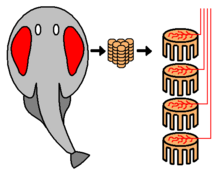
Back Elektroplax German Órgano eléctrico (biología) Spanish Elektrielund Estonian اندام برقی Persian Sähköelin Finnish Organe électrique French Organ listrik (biologi) ID Organo elettrico (biologia) Italian Электр органдар Kirghiz Narządy elektryczne Polish

In biology, the electric organ is an organ that an electric fish uses to create an electric field. Electric organs are derived from modified muscle or in some cases nerve tissue, called electrocytes, and have evolved at least six times among the elasmobranchs and teleosts. These fish use their electric discharges for navigation, communication, mating, defence, and in strongly electric fish also for the incapacitation of prey.
The electric organs of two strongly electric fish, the torpedo ray and the electric eel were first studied in the 1770s by John Walsh, Hugh Williamson, and John Hunter. Charles Darwin used them as an instance of convergent evolution in his 1859 On the Origin of Species. Modern study began with Hans Lissmann's 1951 study of electroreception and electrogenesis in Gymnarchus niloticus.
© MMXXIII Rich X Search. We shall prevail. All rights reserved. Rich X Search